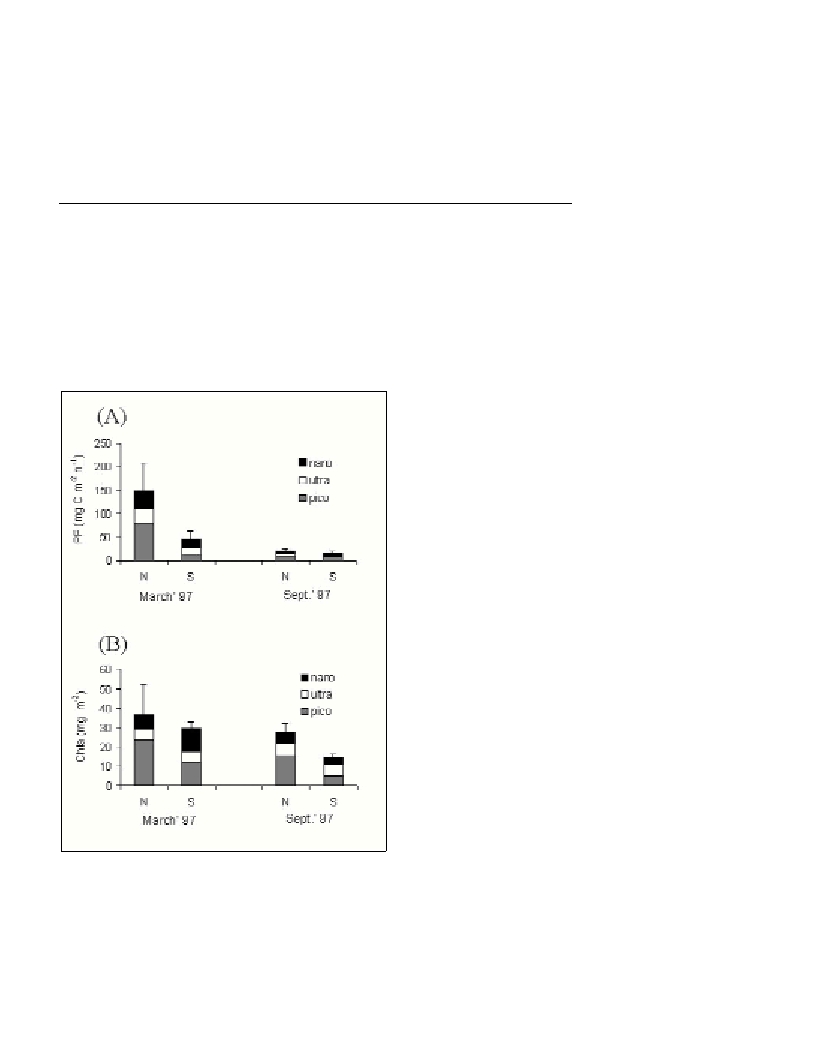Rapp. Comm. int. Mer Médit., 37,2004
237
EFFECTS OF OLIGOTROPHY GRADIENTS ON PELAGIC PRIMARY PRODUCTION
IN THE AEGEAN SEA (EASTERN MEDITERRANEAN)
S. Psarra
1*
, L. Ignatiades
2
, K.Pagou
3
, G. Assimakopoulou
3
, O. Gotsis-Skretas
3
, A. Tselepides
1
& P. Raimbault
4
1
Institute of Marine Biology of Crete (IMBC), POB 2214 Iraklio 71003, Crete, Greece - *spsarra@imbc.gr,
2
Institute of Biology, National Research Centre Democritos, POB 60228, 15310 Ag. Paraskevi, Athens, Greece
3
Institute of Oceanography, National Centre for Marine Research, POB 712, 190 13 Anavissos Attikis, Greece
4
Laboratoire d’Océanographie et de Biogeochimie (UMR CNRS 6535), Centre d’Océanologie de Marseille, Campus de Luminy,
F-13288 Marseille cedex, France
Keywords : Primary production – Phytoplankton - Oligotrophy – Aegean Sea -Eastern Mediterranean
Primary production was measured on a north-south oligotrophy
gradient in the Aegean Sea* (1). Hydrological characteristics revealed
a permanently stratified system in the North, in?uenced by Black Sea
Waters (BSW) whereas the South alternated from highly stratified to
well-mixed conditions in summer and winter, respectively (2).
Despite the lack of important differences in nutrient concentrations,
chlorophyll and primary production during the spring bloom were
higher in the North (Fig. 1), based mainly on picoplankton and regen-
erated nitrogen forms, while diatoms were absent. Thus, the high pri-
mary production rates could be supported by the high organic matter
inputs of BSW origin through regeneration processes (3).
* This work was integrated in the EU project MATER.
Fig. 1. Primary production (A) and chlorophyll-a (B) size-fractionated
measurements, in the North (N) and the South (S) Aegean Sea, during
March and September ‘07. Size fractions correspond to 0.2-1.2
µ
m, 1.2-
3
µ
m and > 3
µ
m, representing pico-, ultra- and nano-phytoplankton,
respectively. Error bars represent the SD of total primary production and
total chla between the stations in the two basins.
References
1-Ignatiades, L. Psarra, S., Zervakis, V., Pagou, K., Souvermezoglou, E.,
Assimakopoulou, G. and Gotsis-Skretas, O., 2002. Phytoplankton size-
based dynamics in the Aegean Sea (Eastern Mediterranean). J. Mar. Sys.,
36: 11-28.
2-Lykousis, V. Chronis, G., Tselepides, A., Price, B., Theocharis, A.,
Siokou-Frangou, I., Van Wambeke, F., Danovaro, R., Stavrakakis, S.,
Duineveld, G., Georgopoulos, D., Ignatiades, L., Souvermezoglou, A. and
Voutsinou-Taliadouri, F., 2002. Major outputs of the recent multidiscipli-
nary biogeochemical researches undertaken in the Aegean Sea. J. Mar.
Sys., 33-34: 313-334.
3-Siokou-Frangou, I., Bianchi, M., Christaki, U., Christou, E.,
Giannakourou, A., Gotsis, O., Ignatiades, L., Pagou, K., Pitta, P., Psarra,
S., Souvermezoglou, E., Van Wambeke, F. and Zervakis, V., 2002. Organic
carbon partitioning and carbon ?ow along a gradient of oligotrophy in the
Aegean Sea (Mediterranean Sea). J. Mar. Sys., 33-34: 335-353.

